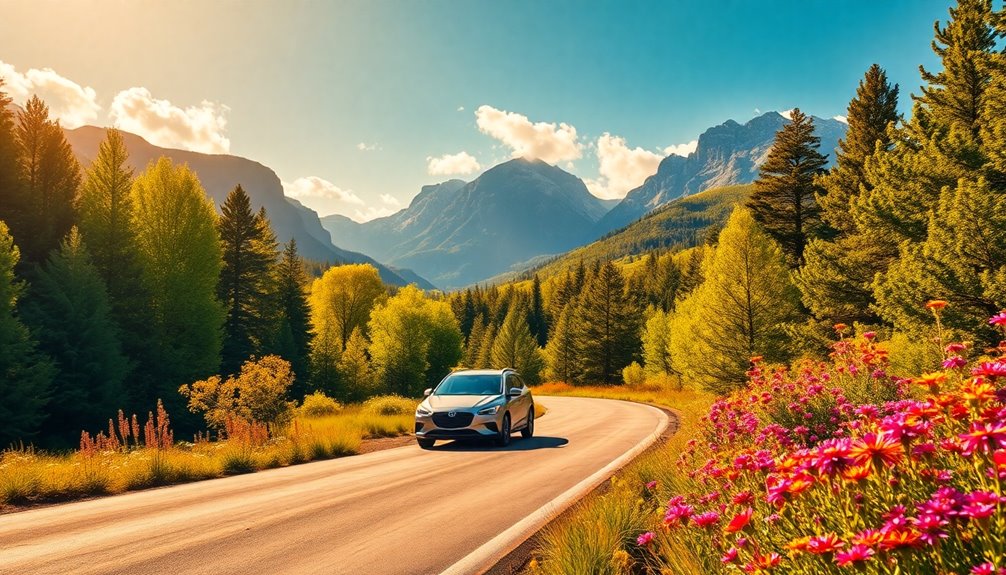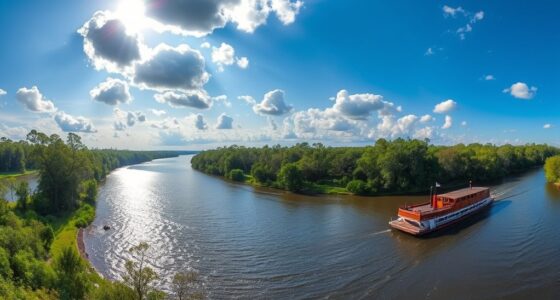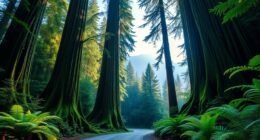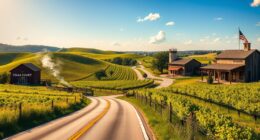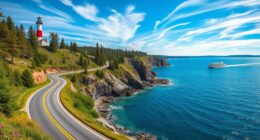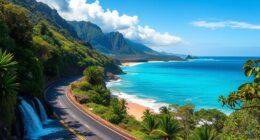Driving through America's national parks isn't just about the scenery; it comes with challenges. Crowds are growing, with 325.5 million visits last year. You need to plan ahead for vehicle checks, parking, and trail choices. Be ready for unpredictable weather and always carry enough water. Wildlife encounters are common, so keep your distance. Want to know some hidden gems and essential tips for a smoother experience? Keep exploring to uncover more secrets of these breathtaking landscapes.
Key Takeaways
- Overcrowding can lead to traffic congestion; arrive early or choose less popular trails for a more enjoyable experience.
- Vehicle checks are essential; ensure your car is in good condition to avoid breakdowns.
- Stay hydrated, especially in hot desert areas, carrying at least one gallon of water per person per day.
- Be prepared for rapidly changing weather conditions; check forecasts and pack accordingly for unexpected storms.
- Maintain a safe distance from wildlife; familiarize yourself with their behaviors to ensure safe encounters.
The Growing Crowds: Understanding Overcrowding in National Parks
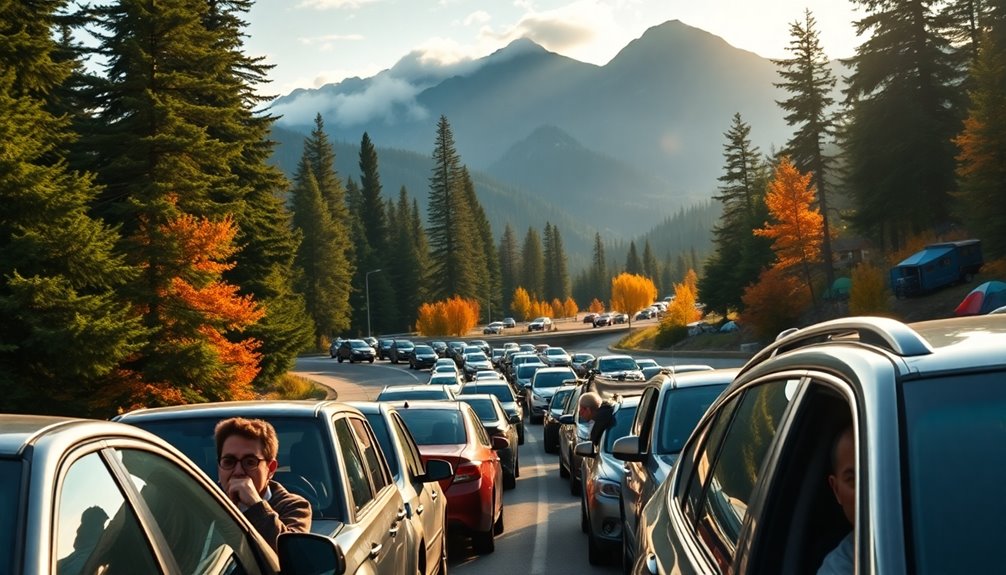
Have you ever wondered why some national parks feel more like bustling cities than serene escapes? In 2023, the National Park Service recorded 325.5 million recreation visits, a 4% increase from the previous year, with 28% of those visits at national parks.
This surge contributes considerably to overcrowding, especially in iconic spots like Smith Rock State Park and the Columbia River Gorge. Finding parking can be a challenge, particularly after 8 a.m.
To combat this, parks like Yosemite and Zion have introduced vehicle permitting systems for peak hours. Overcrowding leads to traffic congestion at popular sites like Avalanche Lake, making it essential for you to explore less frequented areas for a more enjoyable experience while preserving the park's natural beauty.
Essential Preparation for Driving Through National Parks
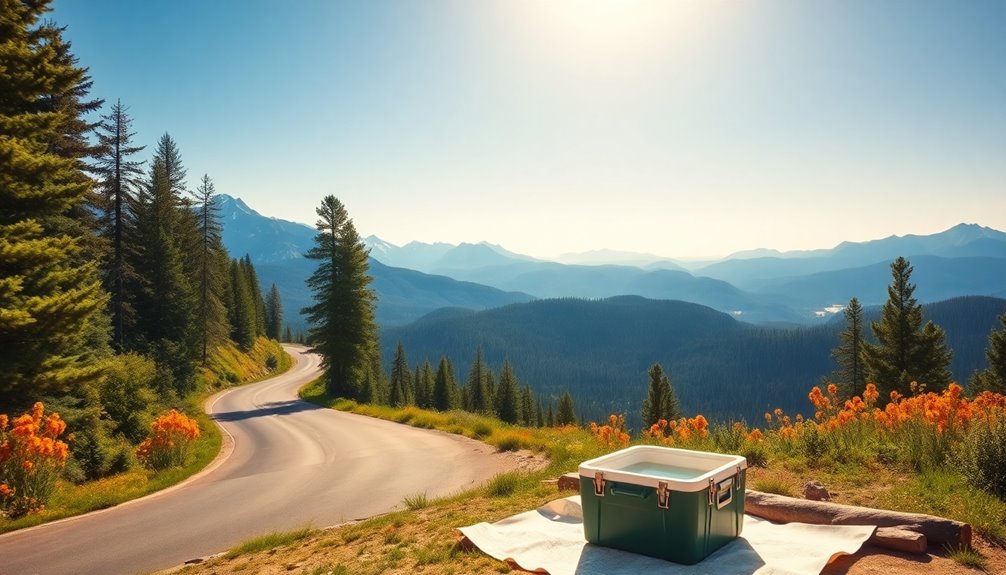
With the increase in visitors to national parks, preparing for a smooth driving experience is more important than ever.
Before you hit the road, make sure your vehicle's in top shape by checking the systems, including oil and tires. Plan your route and be mindful of peak visitor times to avoid frustration.
- Bring plenty of water—aim for a gallon per person per day.
- Familiarize yourself with local wildlife and maintain a safe distance.
- Prepare for varying weather conditions, especially extreme heat in desert parks.
These steps will help you navigate the stunning landscapes of national parks while keeping you safe and comfortable.
Enjoy the journey, and don't forget to take in the breathtaking views!
Navigating Weather Challenges: From Sun to Storm
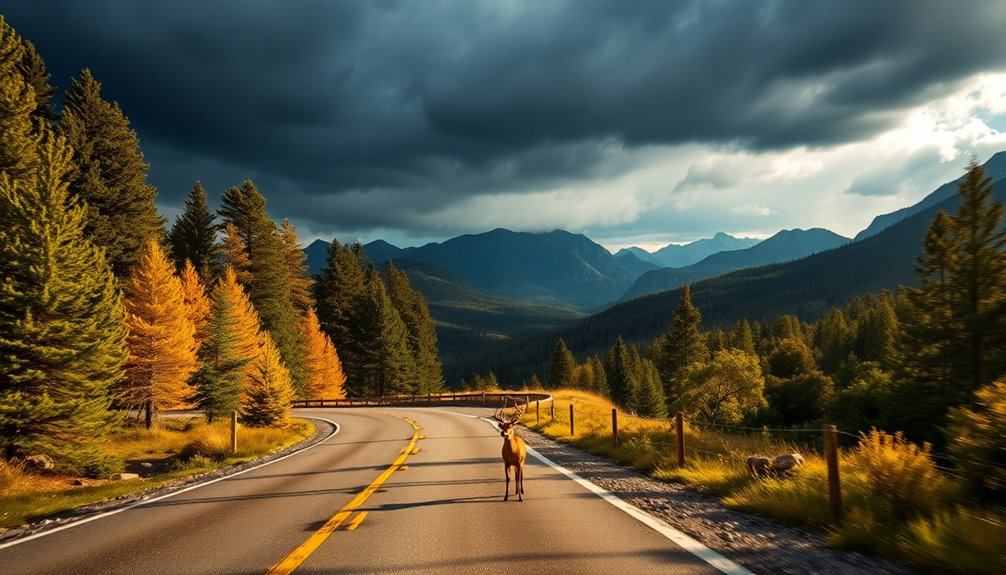
As you commence your journey through America's national parks, be prepared for a spectrum of weather challenges that can range from scorching sun to sudden storms.
The National Park Service warns that desert regions can bring intense heat, leading to dehydration if you're not adequately prepared. It's recommended to carry a gallon of water per person, per day, especially in high temperatures.
Conversely, mountainous areas can face unexpected storms, drastically reducing visibility and requiring you to drive cautiously.
Always check the weather forecasts before heading out, as conditions can shift rapidly. Being aware of these challenges guarantees not only your safety but also enhances your experience as you explore the breathtaking beauty of the parks.
The Importance of Hydration and Sun Protection
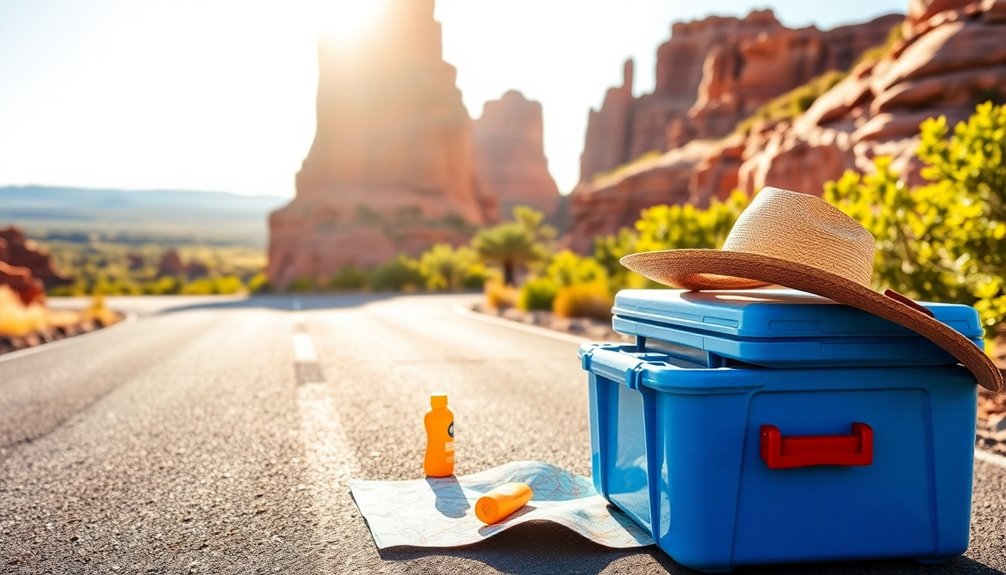
When you're exploring national parks, staying hydrated is essential, especially in the heat.
Don't underestimate your water needs; aim for up to a gallon a day and carry your own supply.
Additionally, protect yourself from the sun with hats, sunglasses, and sunscreen to avoid heat-related illnesses and enjoy your adventure safely.
Hydration Needs Assessment
Staying hydrated is essential for enjoying your time in America's national parks, especially in hot and arid environments.
Many visitors underestimate their hydration needs, risking dehydration during hikes. To stay safe and energized, consider these tips:
- Carry up to a gallon of water per person per day.
- Use water bottle filling stations near trailheads to refill your supplies.
- Avoid sharing limited water among family members, especially with children. Additionally, proper hydration can significantly enhance your overall outdoor experience and performance.
Sun Protection Essentials
While exploring America's stunning national parks, protecting yourself from the sun is just as essential as staying hydrated. The intense desert heat can catch you off guard, so it's important to prioritize sun protection essentials.
Always pack a wide-brimmed hat and high-quality sunglasses to shield your face and eyes from harmful UV rays. Don't forget to apply a generous amount of sunscreen—choose one with an SPF of at least 30 and reapply every two hours, especially during strenuous hikes.
Dehydration Risks Awareness
How can you fully enjoy the wonders of America's national parks without being mindful of hydration? Staying hydrated is essential, especially in hot conditions where you might underestimate your needs. Aim to drink up to a gallon of water per person, per day, and remember to refill at hydration stations near trailheads and ranger stations.
- Desert heat can be intense and lead to heat-related illnesses.
- Families often share insufficient water supplies during hikes.
- Sun protection is critical—wear hats, sunglasses, and sunscreen.
Planning ahead guarantees everyone in your group stays hydrated and protected from the sun, letting you fully appreciate the stunning landscapes of the national park without facing the risks of dehydration.
Choosing the Right Footwear for Diverse Trails
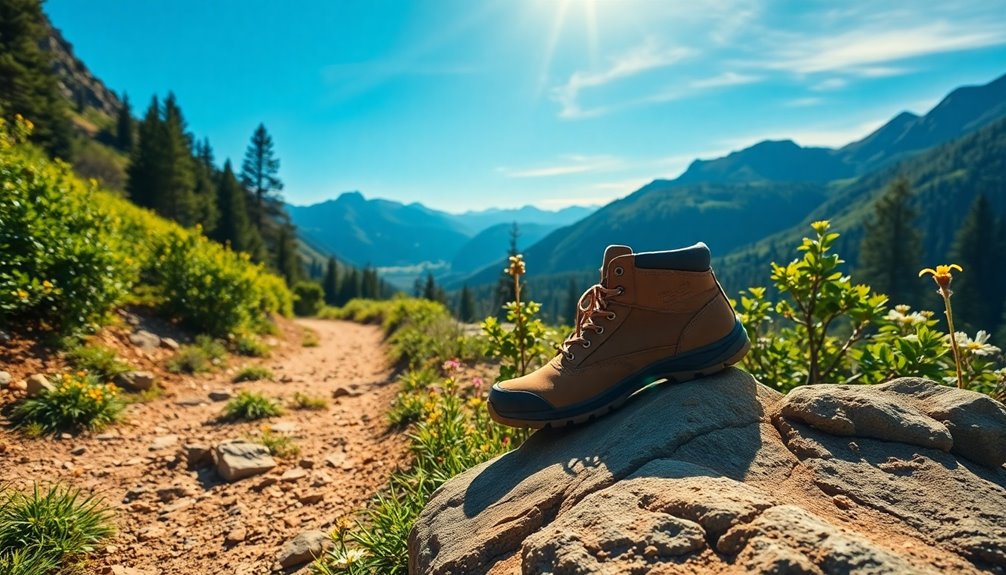
What type of footwear do you need for the variety of trails you'll encounter in America's national parks? When visiting places like Arches National Park, sturdy sneakers or hiking boots are essential.
The rugged terrain can be uneven, and flip-flops won't cut it; they increase your risk of slips and injuries. If you're sticking to paved paths, lighter shoes might suffice, but for unpaved and steep trails, opt for more supportive options.
Many underestimate the importance of proper footwear, which not only enhances safety near drop-offs but also boosts your overall hiking performance.
The park service recommends adequate footwear to navigate diverse conditions, ensuring you enjoy the breathtaking landscapes without discomfort or risk.
Strategies for Managing Parking and Trail Crowds
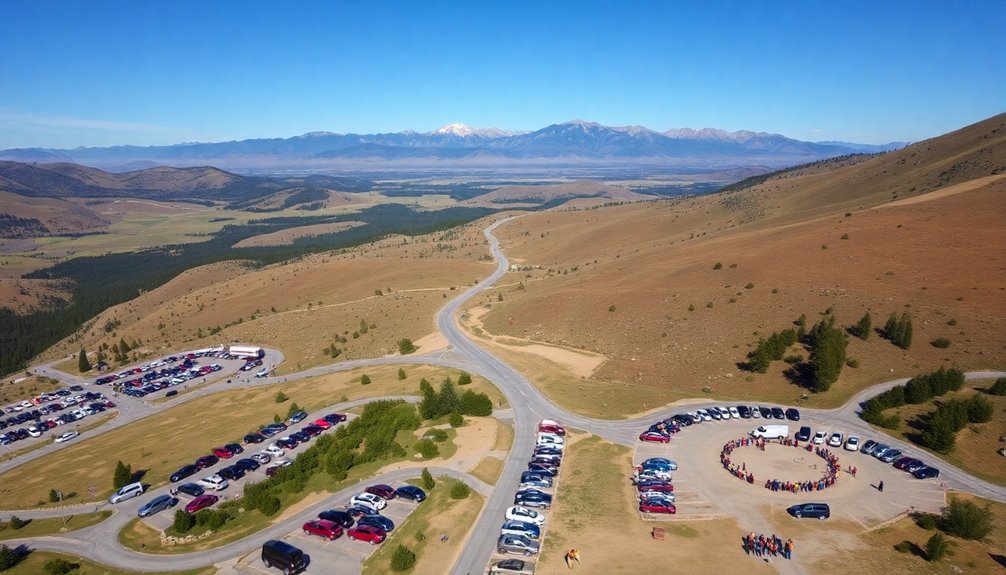
To tackle parking and trail crowds in national parks, you should plan to arrive early in the morning.
Exploring less popular trails can also lead to a more peaceful experience while avoiding the hustle.
Finally, consider using park shuttle services to navigate busy areas efficiently.
Visit Early Morning Hours
Arriving at popular national parks early in the morning can make a world of difference in your visit. By getting there before 8 a.m., you'll greatly improve your chances of finding parking and enjoying iconic sites without the crowds.
Here's what you can expect during those early morning hours:
- Serene trails with as few as 20 fellow hikers on a 10-mile trek
- Increased chances of spotting wildlife, as animals are more active
- Breathtaking views of landscapes bathed in the soft light of dawn
With visitor numbers peaking later in the day, maximizing your time in the early morning not only enhances your experience but also allows you to fully appreciate the beauty of nature without distractions.
Explore Less Popular Trails
Many visitors often overlook the charm of less popular trails in national parks, but exploring these paths can greatly enhance your experience. Instead of battling crowds on iconic hikes, you might encounter only about 20 people during a 10-mile trek.
This tranquility lets you truly connect with nature while exploring the view in peace. Early morning visits to these hidden gems can also help you find parking easily and savor the stunning sights before others arrive.
Many parks feature alternative scenic spots as breathtaking as their famous counterparts. Plus, utilizing vehicle permitting systems encourages a spread to less crowded trails, ensuring a more enjoyable adventure. Additionally, many parks have family-friendly amenities that can enhance your visit, making it even more enjoyable.
Don't hesitate to seek nearby recreational areas for a rejuvenating change too!
Utilize Park Shuttle Services
While exploring the breathtaking landscapes of national parks, you can greatly enhance your experience by utilizing park shuttle services.
These shuttles not only reduce traffic congestion and parking hassles but also help you enjoy iconic sites without the stress.
- Access stunning viewpoints like Multnomah Falls and Glacier National Park's hot spots.
- Plan your visit around a timed schedule to avoid peak crowds.
- Enjoy an economical, eco-friendly option typically included with entrance fees.
Nighttime Driving: Tips for Safety and Visibility
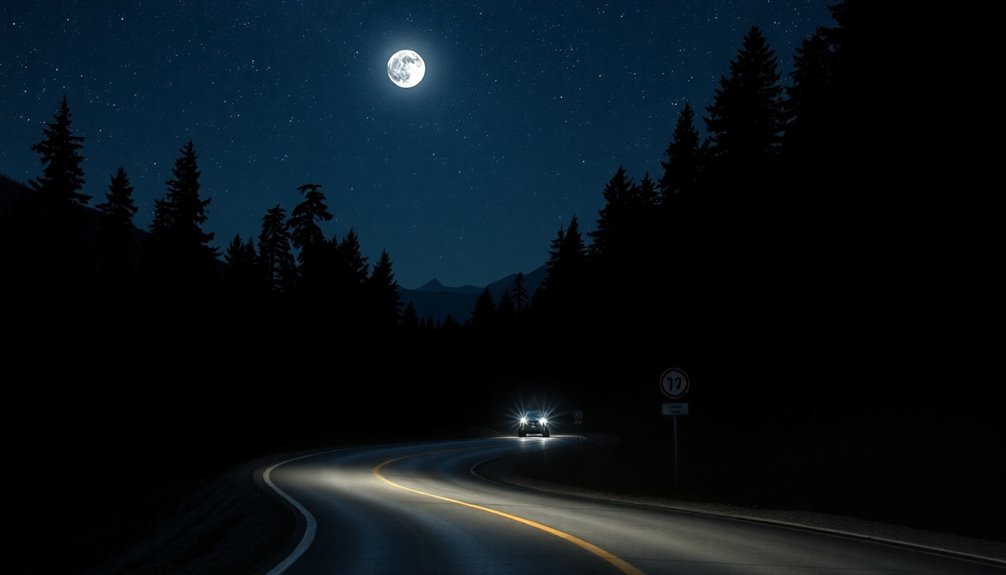
Driving at night in America's national parks can be both thrilling and challenging, especially when visibility is compromised. To guarantee your safety during nighttime driving, start by keeping your windshield clear and checking that your headlights work properly.
Fatigue can hit hard, so make sure you're well-rested before your trip, and don't hesitate to pull over for a nap if you feel drowsy. Avoid stopping in dark areas where hazards like wildlife might be hard to see.
Stick to speed limits to improve your reaction time to unexpected obstacles. Plan your longer drives for daylight hours whenever possible, as reduced visibility at night greatly raises the risks of maneuvering through these beautiful but treacherous landscapes.
Encountering Wildlife: Safety Guidelines and Best Practices

When exploring America's national parks, keeping a safe distance from wildlife is essential for your safety and that of the animals.
Approaching wildlife can provoke unpredictable behavior and lead to dangerous encounters.
Always remember these best practices:
- Use telephoto lenses or zoom features to capture photos from a safe distance.
- Familiarize yourself with local wildlife and their unique behaviors, like bears or moose.
- Stay vigilant and observant while hiking, as animals can appear unexpectedly.
Exploring Less Crowded Areas for a Better Experience
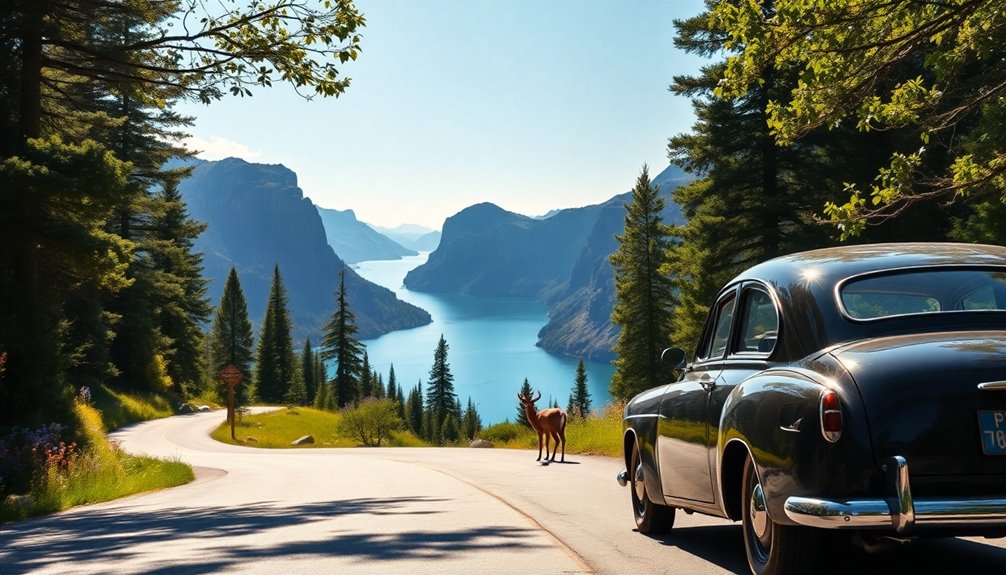
Exploring less crowded areas within America's national parks can transform your experience, offering tranquility and a deeper connection with nature. The National Park Service encourages you to venture off the beaten path, where you might only see about 20 people on a 10-mile hike. This not only enhances your visit but also helps alleviate overcrowding in popular spots.
Here's a quick guide to help you find those hidden gems:
| Strategy | Description |
|---|---|
| Use Physical Maps | Discover lesser-known trails and spots |
| Visit Early Morning | Beat the crowds for a peaceful experience |
| Choose Off-Peak Seasons | Enjoy nature with fewer visitors |
| Explore Alternative Trails | Find solitude away from popular paths |
Embrace these tips and enjoy the serenity!
Embracing the Beauty: Scenic Stops and Hidden Gems

While many visitors flock to the iconic attractions of America's national parks, discovering scenic stops and hidden gems can lead to unforgettable moments.
Take the time to pull off the main roads and embrace the breathtaking views that await. You’ll appreciate diverse landscapes without the need for extensive hiking. As you meander through charming byways and hidden paths, you’ll discover quaint towns, picturesque farms, and stunning vistas that often go overlooked. Each stop offers a unique opportunity to connect with the local culture and capture unforgettable photographs. When planning a successful road trip, remember that the journey itself can be just as rewarding as the destination.
- Enjoy the tranquility of Pinnacles National Park, where fewer crowds reveal surprising beauty.
- Visit the Amphitheater in Bryce Canyon for stunning panoramas easily accessed by car.
- Use physical maps to uncover lesser-known trails and viewpoints, ensuring a peaceful outdoor experience.
Don't forget to rise early and visit renowned locations before the tourist rush.
These moments will deepen your connection to nature and enhance your adventure.
Frequently Asked Questions
What Do I Need to Know About Driving off Road in National Parks?
When you're planning to drive off-road in national parks, you need to check park regulations and conditions first.
Make certain your vehicle's equipped for rough terrain, including proper tires and a spare.
Always carry a physical map since GPS can fail in remote areas.
Stay alert for wildlife crossings, and familiarize yourself with designated trails to minimize impact.
Being prepared will guarantee a safer and more enjoyable experience while exploring the great outdoors.
What Is the #1 Cause of Death in National Parks?
Oh, you thought hiking in blissful nature was all about selfies and fresh air? Think again!
The number one cause of death in national parks is drowning. Yep, those picturesque rivers and lakes can turn deadly, especially with unexpected currents or icy waters.
So, before you take that invigorating dip, remember that roughly 25% of park fatalities involve water incidents.
Stay alert and respect the wild; it doesn't always play nice!
Has Anyone Visited All 63 National Parks?
Yes, a handful of adventurers have successfully visited all 63 national parks in the United States. You might find their journeys inspiring, as they share their experiences on social media and blogs.
Many prioritize iconic parks like Yellowstone and Yosemite, but don't overlook the lesser-known gems.
If you're planning a similar adventure, be ready for extensive planning and diverse terrains—each park offers unique natural beauty waiting for you to explore.
Is It Illegal to Take Anything From a National Park?
Imagine wandering through a living gallery of nature, where every rock and leaf tells a story.
It's illegal to take anything from a national park, and there's a good reason for that. Removing natural or cultural resources harms ecosystems and disrespects the rich history embedded in the land.
You might think it's harmless, but each small act of removal disrupts the delicate balance, so always leave nature as you found it, untouched and beautiful.
Conclusion
As you venture through America's national parks, remember that nearly 300 million visitors flock to these stunning landscapes each year. This staggering number highlights the importance of planning your trip wisely to avoid the crowds and truly appreciate nature's beauty. By preparing ahead, staying safe, and exploring lesser-known areas, you can experience the serenity and magic of these parks in a way that many miss. So gear up, hit the road, and embrace the adventure that awaits!
